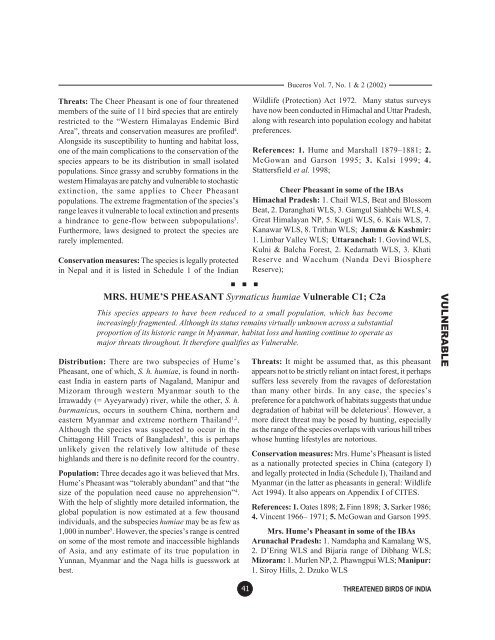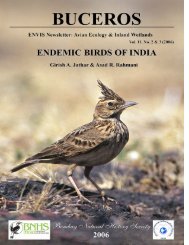Untitled - ENVIS Centre on Avian Ecology
Untitled - ENVIS Centre on Avian Ecology
Untitled - ENVIS Centre on Avian Ecology
Create successful ePaper yourself
Turn your PDF publications into a flip-book with our unique Google optimized e-Paper software.
Threats: The Cheer Pheasant is <strong>on</strong>e of four threatened<br />
members of the suite of 11 bird species that are entirely<br />
restricted to the “Western Himalayas Endemic Bird<br />
Area”, threats and c<strong>on</strong>servati<strong>on</strong> measures are profiled 4 .<br />
Al<strong>on</strong>gside its susceptibility to hunting and habitat loss,<br />
<strong>on</strong>e of the main complicati<strong>on</strong>s to the c<strong>on</strong>servati<strong>on</strong> of the<br />
species appears to be its distributi<strong>on</strong> in small isolated<br />
populati<strong>on</strong>s. Since grassy and scrubby formati<strong>on</strong>s in the<br />
western Himalayas are patchy and vulnerable to stochastic<br />
extincti<strong>on</strong>, the same applies to Cheer Pheasant<br />
populati<strong>on</strong>s. The extreme fragmentati<strong>on</strong> of the species’s<br />
range leaves it vulnerable to local extincti<strong>on</strong> and presents<br />
a hindrance to gene-flow between subpopulati<strong>on</strong>s 3 .<br />
Furthermore, laws designed to protect the species are<br />
rarely implemented.<br />
C<strong>on</strong>servati<strong>on</strong> measures: The species is legally protected<br />
in Nepal and it is listed in Schedule 1 of the Indian<br />
n n n<br />
Buceros Vol. 7, No. 1 & 2 (2002)<br />
Wildlife (Protecti<strong>on</strong>) Act 1972. Many status surveys<br />
have now been c<strong>on</strong>ducted in Himachal and Uttar Pradesh,<br />
al<strong>on</strong>g with research into populati<strong>on</strong> ecology and habitat<br />
preferences.<br />
References: 1. Hume and Marshall 1879–1881; 2.<br />
McGowan and Gars<strong>on</strong> 1995; 3. Kalsi 1999; 4.<br />
Stattersfield et al. 1998;<br />
Cheer Pheasant in some of the IBAs<br />
Himachal Pradesh: 1. Chail WLS, Beat and Blossom<br />
Beat, 2. Daranghati WLS, 3. Gamgul Siahbehi WLS, 4.<br />
Great Himalayan NP, 5. Kugti WLS, 6. Kais WLS, 7.<br />
Kanawar WLS, 8. Trithan WLS; Jammu & Kashmir:<br />
1. Limbar Valley WLS; Uttaranchal: 1. Govind WLS,<br />
Kulni & Balcha Forest, 2. Kedarnath WLS, 3. Khati<br />
Reserve and Wacchum (Nanda Devi Biosphere<br />
Reserve);<br />
MRS. HUME’S PHEASANT Syrmaticus humiae Vulnerable C1; C2a<br />
This species appears to have been reduced to a small populati<strong>on</strong>, which has become<br />
increasingly fragmented. Although its status remains virtually unknown across a substantial<br />
proporti<strong>on</strong> of its historic range in Myanmar, habitat loss and hunting c<strong>on</strong>tinue to operate as<br />
major threats throughout. It therefore qualifies as Vulnerable.<br />
Distributi<strong>on</strong>: There are two subspecies of Hume’s<br />
Pheasant, <strong>on</strong>e of which, S. h. humiae, is found in northeast<br />
India in eastern parts of Nagaland, Manipur and<br />
Mizoram through western Myanmar south to the<br />
Irrawaddy (= Ayeyarwady) river, while the other, S. h.<br />
burmanicus, occurs in southern China, northern and<br />
eastern Myanmar and extreme northern Thailand1,2 .<br />
Although the species was suspected to occur in the<br />
Chittag<strong>on</strong>g Hill Tracts of Bangladesh3 , this is perhaps<br />
unlikely given the relatively low altitude of these<br />
highlands and there is no definite record for the country.<br />
Populati<strong>on</strong>: Three decades ago it was believed that Mrs.<br />
Hume’s Pheasant was “tolerably abundant” and that “the<br />
size of the populati<strong>on</strong> need cause no apprehensi<strong>on</strong>” 4 .<br />
With the help of slightly more detailed informati<strong>on</strong>, the<br />
global populati<strong>on</strong> is now estimated at a few thousand<br />
individuals, and the subspecies humiae may be as few as<br />
1,000 in number5 . However, the species’s range is centred<br />
<strong>on</strong> some of the most remote and inaccessible highlands<br />
of Asia, and any estimate of its true populati<strong>on</strong> in<br />
Yunnan, Myanmar and the Naga hills is guesswork at<br />
best.<br />
Threats: It might be assumed that, as this pheasant<br />
appears not to be strictly reliant <strong>on</strong> intact forest, it perhaps<br />
suffers less severely from the ravages of deforestati<strong>on</strong><br />
than many other birds. In any case, the species’s<br />
preference for a patchwork of habitats suggests that undue<br />
degradati<strong>on</strong> of habitat will be deleterious5 . However, a<br />
more direct threat may be posed by hunting, especially<br />
as the range of the species overlaps with various hill tribes<br />
whose hunting lifestyles are notorious.<br />
C<strong>on</strong>servati<strong>on</strong> measures: Mrs. Hume’s Pheasant is listed<br />
as a nati<strong>on</strong>ally protected species in China (category I)<br />
and legally protected in India (Schedule I), Thailand and<br />
Myanmar (in the latter as pheasants in general: Wildlife<br />
Act 1994). It also appears <strong>on</strong> Appendix I of CITES.<br />
References: 1. Oates 1898; 2. Finn 1898; 3. Sarker 1986;<br />
4. Vincent 1966– 1971; 5. McGowan and Gars<strong>on</strong> 1995.<br />
Mrs. Hume’s Pheasant in some of the IBAs<br />
Arunachal Pradesh: 1. Namdapha and Kamalang WS,<br />
2. D’Ering WLS and Bijaria range of Dibhang WLS;<br />
Mizoram: 1. Murlen NP, 2. Phawngpui WLS; Manipur:<br />
1. Siroy Hills, 2. Dzuko WLS<br />
41 THREATENED BIRDS OF INDIA<br />
VULNERABLE




